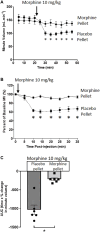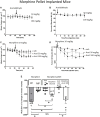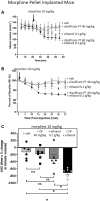Role of Acetaldehyde in Ethanol Reversal of Tolerance to Morphine-Induced Respiratory Depression in Mice
- PMID: 35909497
- PMCID: PMC7613180
- DOI: 10.3389/adar.2021.10143
Role of Acetaldehyde in Ethanol Reversal of Tolerance to Morphine-Induced Respiratory Depression in Mice
Abstract
Background: Opioid users regularly consume other drugs such as alcohol (ethanol). Acute administration of ethanol rapidly reverses tolerance to morphine-induced respiratory depression. However, recent research has suggested that the primary metabolite of ethanol, acetaldehyde, may play a key role in mediating the CNS effects seen after ethanol consumption. This research investigated the role of acetaldehyde in ethanol reversal of tolerance to morphine-induced respiratory depression.
Methods: Tolerance was induced in mice by 6-days implantation of a 75 mg morphine pellet with control mice implanted with a placebo pellet. Tolerance was assessed by acute morphine administration on day 6 and respiration measured by plethysmography. Levels of acetaldehyde were inhibited or enhanced by pre-treatments with the acetaldehyde chelator D-penicillamine and the inhibitor of acetaldehyde dehydrogenase disulfiram respectively.
Results: Morphine pellet implanted mice displayed tolerance to an acute dose of morphine compared to placebo pellet implanted controls. Acute acetaldehyde administration dose-dependently reversed tolerance to morphine respiratory depression. As previously demonstrated, ethanol reversed morphine tolerance, and this was inhibited by D-penicillamine pre-treatment. An acute, low dose of ethanol that did not significantly reverse morphine tolerance was able to do so following disulfiram pre-treatment.
Conclusion: These data suggest that acetaldehyde, the primary metabolite of ethanol, is responsible for the reversal of morphine tolerance observed following ethanol administration.
Keywords: acetaldehyde; ethanol; morphine; opioid; polydrug; polypharmacology; respiration; tolerance.
Conflict of interest statement
Conflict of Interest The authors declare that the research was conducted in the absence of any commercial or financial relationships that could be construed as a potential conflict of interest.
Figures




Similar articles
-
Prolonged ethanol administration prevents the development of tolerance to morphine-induced respiratory depression.Drug Alcohol Depend. 2019 Dec 1;205:107674. doi: 10.1016/j.drugalcdep.2019.107674. Epub 2019 Oct 30. Drug Alcohol Depend. 2019. PMID: 31715438
-
Ethanol Reversal of Tolerance to the Respiratory Depressant Effects of Morphine.Neuropsychopharmacology. 2016 Feb;41(3):762-73. doi: 10.1038/npp.2015.201. Epub 2015 Jul 14. Neuropsychopharmacology. 2016. PMID: 26171718 Free PMC article.
-
Oxycodone-induced tolerance to respiratory depression: reversal by ethanol, pregabalin and protein kinase C inhibition.Br J Pharmacol. 2018 Jun;175(12):2492-2503. doi: 10.1111/bph.14219. Epub 2018 May 7. Br J Pharmacol. 2018. PMID: 29574756 Free PMC article.
-
Interaction of biogenic amines with ethanol.Adv Exp Med Biol. 1975;56:265-75. doi: 10.1007/978-1-4684-7529-6_13. Adv Exp Med Biol. 1975. PMID: 238368 Review.
-
The UChA and UChB rat lines: metabolic and genetic differences influencing ethanol intake.Addict Biol. 2006 Sep;11(3-4):310-23. doi: 10.1111/j.1369-1600.2006.00030.x. Addict Biol. 2006. PMID: 16961761 Review.
References
Grants and funding
LinkOut - more resources
Full Text Sources
Research Materials

